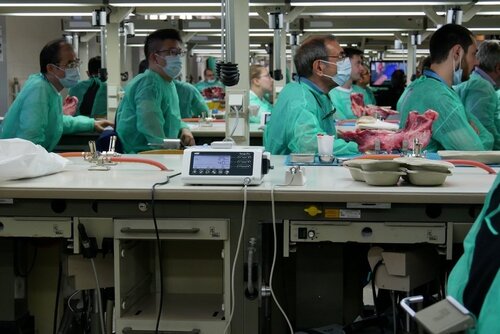![]()
23 September 2018
Use of L-PRF in regeneration under spotlight at Leuven meeting
Categories:Clinical Practice, Education

At a three-day meeting organised by the periodontal department of the Catholic University of Leuven (Belgium) – one of the 16 universities to offer EFP-accredited postgraduate education in periodontology – clinicians heard from experts about the latest developments in the use of L-PRF in the regeneration of hard and soft tissues.
The event, the 2nd European Meeting on Enhanced Natural Healing in Dentistry, focused on the latest advances in the use of L-PRF (leucocyte and platelet rich fibrin), a second-generation platelet concentrate that is made from the patient’s own blood.
Attended by 450 dental professionals from 40 countries, the event featured 27 speakers and included surgical presentations, a hands-on workshop, and poster presentations as well as the lectures and panel discussions.
On Friday, September 7 there was a workshop presented by Marc Quirynen and Andy Temmerman (both from the Catholic University of Leuven), with video presentations on surgical intervention, and a hands-on session given by Nelson Pinto (University of the Andes, Chile) and the Leuven team showing how to prepare L-PRF membranes and a L-PRF bone block, and how to apply them during ridge preservation, implant coating, and bone augmentation.
The programme on Saturday, September 8 featured, after an introduction from Nelson Pinto, five sessions on:
- The benefits of L-PRF for ridge preservation & bone-block grafting, with the keynote lecture given by Juan Blanco (University of Santiago de Compostela, Spain), followed by additional research presentations on: the impact of the centrifuge and timing on the preparation of platelet concentrates, changes in bone morphology after socket preservation with L-PRF versus conventional treatment, and the success of a ‘dentin block’ in alveolar ridge preservation.
- The benefits of L-PRF for the regeneration of periodontal defects (soft and hard tissue), with a keynote lecture by Pierpaolo Cortellini (private clinic, Florence, Italy), followed by presentations on L-PRF in soft-tissue regeneration, the use of L-PRF in periodontal defects during surgical and non-surgical therapy, and the adjunctive effect of autologous platelet-rich fibrin to barrier a membrane in the treatment of periodontal intrabony defects.
- L-PRF block for horizontal bone regeneration, with a keynote lecture by Marc Quirynen on L-PRF block in posterior maxilla sites, followed by presentations on bone augmentation with L-PRF blocks in the posterior mandible, horizontal and vertical guided bone regeneration combining L-PRF, autogenous bone, and liquid fibrinogen, and a report on the experience of L-PRF for horizontal ridge augmentation in private practice.
- Benefits of L-PRF for implant surgery, with a keynote lecture by Andy Temmerman, followed by presentations on guided bone regeneration with L-PRF in the atrophic maxilla – the GLAM technique, lateral and trans-crestal sinus floor elevation in implant therapy with L-RPF, and enhanced oral bone grafting with L-RPF.
- Basic research on how L-PRF can enhance healing: Keynote lecture from Ivo Lambrichts (Hasselt University, Belgium) on the characterisation of L-RPF and its role in healing and tissue regeneration, followed by presentations on underlying processes of L-PRF-mediated repair and its effect on dental-pulp stem cells, the influence of antithrombotic drugs on biomechanical characteristics of L-PRF membranes, comparison of the effect of L-PRF and A-PRF on gingival fibroblast and periodontal ligament fibroblast, and analyses on growth factors and collagen expression on i-PRF.
The morning of Sunday, September 9 was devoted to “sharing clinical experience” and featured panels of clinicians discussing how they approach various interventions with L-PRF. The topics covered recent developments in L-PRF preparation, ridge preservation, periodontal regeneration, sinus augmentation, coating and immediate placement in implant surgery, and L-PRF block.
The clinicians who participated in this session were former EFP president Juan Blanco (Spain), Ana Castro (Belgium), Antonio Sanz (Chile), and Mazen El-Abiad (Canada), together with Nelson Pinto and Andy Temmerman. They were questioned by Wim Teughels and Marc Quirynen (both Leuven) in order to obtain tips and tricks to improve the clinical outcome.
The final session, on the Sunday afternoon, explored how L-PRF can be used to enhance wound healing in chronic wounds such as diabetic foot and venous leg ulcer. Nelson Pinto (Chile), Sushil Koirala (Nepal), and Enrico Rescigno (Italy) highlighted again how L-PRF improves wound healing, even in non-responding “chronic wounds”.
The abstract book of this 2nd European Meeting on Enhanced Natural Healing in Dentistry has been published and can be downloaded in pdf format from the event’s website: www.ENHD2018.be. On the same website, guidelines are available for the use of L-PRF as well as some videos on surgical applications.
“L-PRF should be seen as a mechanically prepared, 100% autogenous ‘super clot’ that contains a large amount of growth factors and essential cells in wound healing,” said Prof Quirynen. “Currently my department is using L-PRF in about 75% of all periodontal interventions, in order to improve the healing and to simplify the intervention.”




